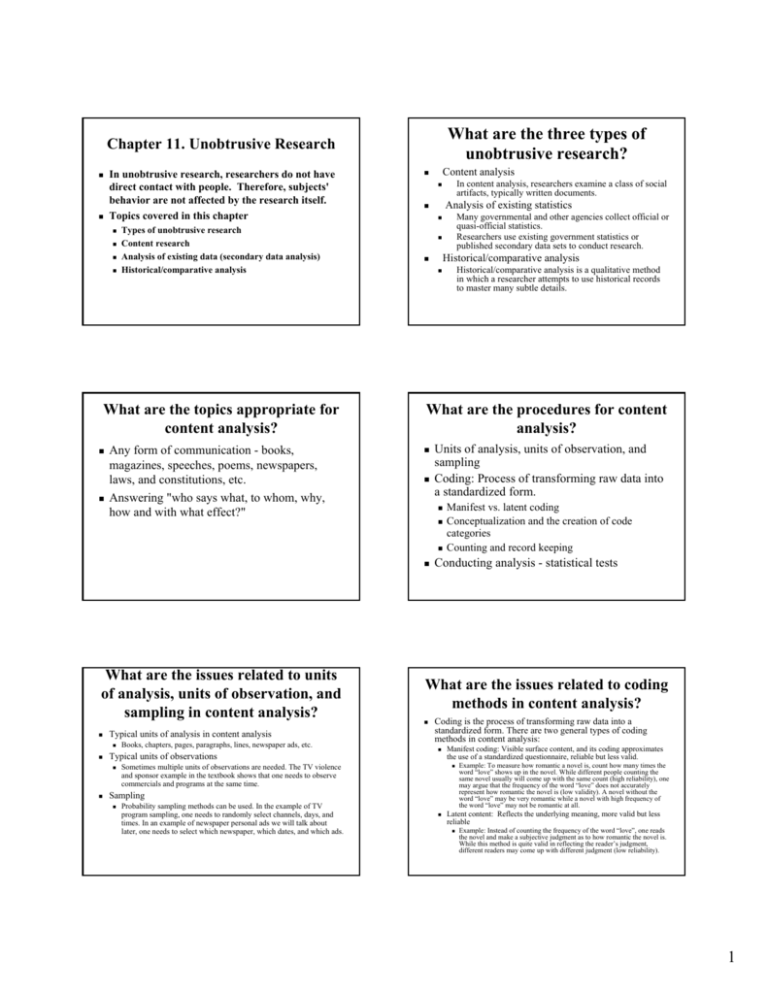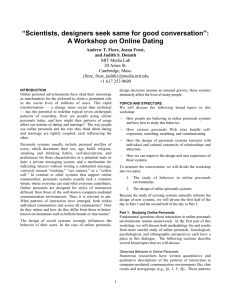
What are the three types of
unobtrusive research?
Chapter 11. Unobtrusive Research
In unobtrusive research, researchers do not have
direct contact with people. Therefore, subjects'
behavior are not affected by the research itself.
Topics covered in this chapter
Types of unobtrusive research
Content research
Analysis of existing data (secondary data analysis)
Historical/comparative analysis
What are the topics appropriate for
content analysis?
Any form of communication - books,
magazines, speeches, poems, newspapers,
laws, and constitutions, etc.
Answering "who says what, to whom, why,
how and with what effect?"
Content analysis
In content analysis, researchers examine a class of social
artifacts, typically written documents.
Analysis of existing statistics
Many governmental and other agencies collect official or
quasiquasi-official statistics.
Researchers use existing government statistics or
published secondary data sets to conduct research.
Historical/comparative analysis
What are the procedures for content
analysis?
Units of analysis, units of observation, and
sampling
Coding: Process of transforming raw data into
a standardized form.
What are the issues related to units
of analysis, units of observation, and
sampling in content analysis?
Typical units of analysis in content analysis
Typical units of observations
Books, chapters, pages, paragraphs, lines, newspaper ads, etc.
Historical/comparative analysis is a qualitative method
in which a researcher attempts to use historical records
to master many subtle details.
Manifest vs. latent coding
Conceptualization and the creation of code
categories
Counting and record keeping
Conducting analysis - statistical tests
What are the issues related to coding
methods in content analysis?
Coding is the process of transforming raw data into a
standardized form. There are two general types of coding
methods in content analysis:
Manifest coding: Visible surface content, and its coding approximates
approximates
the use of a standardized questionnaire, reliable but less valid.
valid.
Sometimes multiple units of observations are needed. The TV violence
violence
and sponsor example in the textbook shows that one needs to observe
observe
commercials and programs at the same time.
Sampling
Probability sampling methods can be used. In the example of TV
program sampling, one needs to randomly select channels, days, and
and
times. In an example of newspaper personal ads we will talk about
about
later, one needs to select which newspaper, which dates, and which
which ads.
Example: To measure how romantic a novel is, count how many times
times the
word “love” shows up in the novel. While different people counting
counting the
same novel usually will come up with the same count (high reliability),
reliability), one
may argue that the frequency of the word “love” does not accurately
accurately
represent how romantic the novel is (low validity). A novel without
without the
word “love” may be very romantic while a novel with high frequency
frequency of
the word “love” may not be romantic at all.
Latent content: Reflects the underlying meaning, more valid but less
reliable
Example: Instead of counting the frequency of the word “love”, one
one reads
the novel and make a subjective judgment as to how romantic the novel is.
While this method is quite valid in reflecting the reader’s judgment,
judgment,
different readers may come up with different judgment (low reliability).
reliability).
1
What are the strengths of content
analysis?
How to determine coding categories?
Quantitative data
Make sure coding categories are exhaustive and mutually exclusive
exclusive
Need to decided how many attributes to use
Record keeping: important to clearly distinguish between unit of
analysis and unit of observation.
Record the base
If one counted 200 romantic words in two novels, it is important to know
how long the novels are. If Novel A has 20,000 words and Novel B only
has a total of $10,000 words, then one knows that Novel B has a higher
frequency of romantic words.
Qualitative data
Negative case testing
Exam records for patterns and generate hypothesis
Find disconfirming cases
FineFine-tune the hypothesis or abandon the hypothesis if cannot be finefinetuned.
Economy of time and money.
Easy to repeat a portion of the study if
necessary.
Permits study of processes over time.
Researcher seldom has any effect on the
subject being studied.
Reliability.
What are the weaknesses of content
analysis?
Limited to the examination of recorded
communications.
Problems of validity are likely.
Here is an example of content
analysis:
Theory: Social exchange theory
Hypotheses:
To the extent heterosexuals are looking for longerlonger-lasting relationships
than homosexuals, they are more likely to use terms related to sincerity
sincerity
and security than homosexuals are.
Because heterosexuals’ ads are likely to reflect traditional gender
gender
stereotypes, the ads of men and women are expected to reflect social
social
exchanges forces. Specifically, women will offer resources men seek,
seek,
and men will offer resources women seek.
For characteristics less important to building a longlong-term relationship
(i.e., attractiveness, expressiveness, instrumentality, sexual references),
references),
sexual orientation will not be so powerful a predictor of ad contents
contents ad
gender. Specifically, women will make more offers of instrumentality
instrumentality
and more appeals for expressiveness than men.
Heterosexual women will make more offers of attractiveness than other
advertisers
Lesbians will make fewer offers of or appeals for attractiveness than
other advertisers.
Gay men will make significantly more offers of and appeals for sexual
sexual
characteristics or activities than other advertisers.
Gonzales, M. and Meyers, S. (1993). “Your
mother would like me”: SelfSelf-presentation in
the personals ads of heterosexual and
homosexual men and women. Personality and
Social Psychology Bulletin, 19(2), 131131- 142.
Exams selfpresentation
strategies
in
the
self
personals ads for heterosexual and homosexual
men and women.
Sampling
Personals ads were selected from three geographical
regions (New York, San Francisco Bay Area, and
Midwest).
Nine newsprint publications.
Published between Oct. 1988 to May 1989
Total personals ads: 2,008
Randomly selected 25 ads written by hetero men, hetero
women, homo men, and homo women in each of the three
geographic region
Final sample size: 300 (25 ads x 2 genders x 2 sexual
orientations x 3 regions)
Note the first stage of selecting newspaper has a quota
sampling nature in it. The second stage of selecting 300
from the total of 2,008 is a stratified sampling method.
2
Note the difference between unit of
observation and unit of analysis
Coding
Unit of observation
Personals ads
Unit of analysis
General information: source, gender, sexual orientation,
race, age, height, weight, hair color, eye color, type of
relationship sought (marriage, occasional), and total
number of words in ad
Frequency of words in each of the six content categories
(offer and appeal, so a total of 12):
Individuals who placed personals ads
Heterosexual
Gay men emphasized physical characteristics most
and lesbians least.
Heterosexual women mentioned attractiveness
more than lesbians did.
Women solicited more expressiveness traits and
offered more instrumental traits than men.
Gay men mentioned sexuality more than other
advisers.
Heterosexuals were more likely than homosexuals
to pursue longlong-term relationships and to mention
sincerity and financial security.
Ad Contents
What topics are appropriate for
analysis of existing data?
Quantitative analysis where good existing data
sets exist
A master list of words is used (see examples above).
Manifest coding.
Each ad was coded by 22-10 trained raters. Discrepancies
were resolved by consensus.
An example of results organized in a Table
Results
Attractiveness: examples: cute, attractive, slender
Financial security: examples: accomplished, established, generous
generous
Expressiveness: examples: affectionate, caring, empathic, sensitive
sensitive
Instrumentality: aggressive, ambitious, competitive, intelligent
Sincerity: commitmentminded,
considerate,
dependable,
faithful
commitment
Sexual references: any reference to physical contact, explicit sexual
sexual
behavior
Men (n=75)
Women (n=75)
Attractiveness offer
63%
71%
Attractiveness appeal
45%
45%
Security offer
53%
43%
Security appeal
5%
32%
Expressiveness offer
35%
31%
Expressiveness appeal
21%
44%
Instrumentality offer
13%
29%
Instrumentality appeal
15%
27%
Sincerity offer
16%
8%
Sincerity appeal
12%
19%
Sexual offer
3%
1%
Sexual appeal
3%
3%
What are the sources of existing
data?
Sources of existing statistics
The Statistical Abstract of the United States
ICPSR
http://www.census.gov/prod/www/statisticalhttp://www.census.gov/prod/www/statistical-abstractabstract-03.html
http://www.lib.utah.edu/icpsr/index.html (U. Of U. page)
http://www.icpsr.umich.edu/ (ICPSR home page)
Many exiting data are very large and complicated. Extensive
training in statistics and computer programming is usually
required.
When using data with the unit of analysis being groups, one
needs to be careful about ecological fallacy (drawing
conclusions about individuals when the unit of analysis is
group).
Replication and logical reasoning are often used to deal with
problems of validity in analyzing existing data
3
What are the strengths and
weaknesses of analyzing existing data?
Strengths
The data may not reflect a particular measure or a particular
question that a social scientist has constructed.
Problem with reliability: Reliability is dependent on the
quality of the statistics
Theories
Weaknesses
Efficiency - time and money
Unobtrusive
Government data usually have very good sampling design
An example of research using
existing data
Parcel et al. (1996). The effects of parental
work and maternal nonemployment on
children’s reading and math achievement
Using a sample of 1,067 99- to 1212-yearyear-old
children of working and nonworking mothers
from the 1992 National Longitudinal survey of
Youth’s ChildChild-Mother data set, the authors
studied the impact of parental work on
children’s reading and math achievement
Sample
James Coleman’s theory regarding family social
capital
Mel Kohn’s ideas regarding work and personality
Major Hypotheses:
Maternal nonemployment per se will generally not
be an asset to older children’s cognitive outcomes
Unit of observation for the NLSY ChildChildMother data:
Each of the biological children born between 1979
and 1992 of the NLSY cohort women.
Measurements
9- to 1212-yearyear-old children of employed and
nonemployed mothers in 1992.
If a mother has more than one child aged 99-12 in
1992, researchers randomly selected one child for
this study.
Dependent variables:
For this study, the sample is
Secondary data: National Longitudinal Survey of
Youth (NLSY).
Ongoing national survey begun in 1979 by the
National Opinion Research Center in Chicago and
the Center for Human Resource Research at Ohio
State.
Originally a multistage stratified area probability
sample of 12,686 youth who were 1414-21 in 1979.
Reinterviews occurred each year
This study used the Merged ChildChild-Mother data in
1992
Math and reading achievement: the Mathematics and
Reading Recognition assessments from the PIAT
Major independent variable:
Occupation complexity: 1919-itemitem-based occupational
complexity scale (Parcel, 1989)
Work hours: not working, (low partpart-time hours (1(1-20),
high partpart-time hours (21(21-34), fullfull-time hours (34(34-40),
and overtime hours (more than 40).
For measurement of other variables see Table 1 on
page 472.
For descriptive statistics of the sample see Table 2.
4
Statistical method used for hypothesis testing
Multiple regression
If you have taken a statistics course, you may be
familiar with this method. If not, just know that this is a
method that can isolate the effect of each variable while
controlling for the effect of other variables.
Findings
Parental work does not have strong direct effects
on cognitive outcomes of 99- to 1212-yearyear-old
children.
The most important predictors of PIAT scores
were the personal characteristics of children as
well as maternal cognitive ability and spouse’s
education.
Low birth weight can profoundly affect children’s
cognitive development.
Comparative and Historical Analysis
Topics appropriate to historical/comparative research
Tracing the development of social forms over time
Comparing development process across culture
Procedures
Analytical techniques
Verstehen - understanding
Hermeneutics - interpretation
Ideal types - patterns
Sources of data
Cautions
Diaries, official documents, publications
Can't trust the accuracy of records - official or unofficial, primary or
secondary.
Must be wary of bias in data sources.
5







